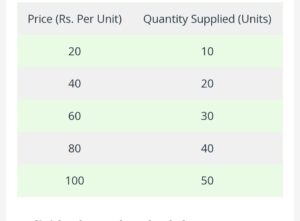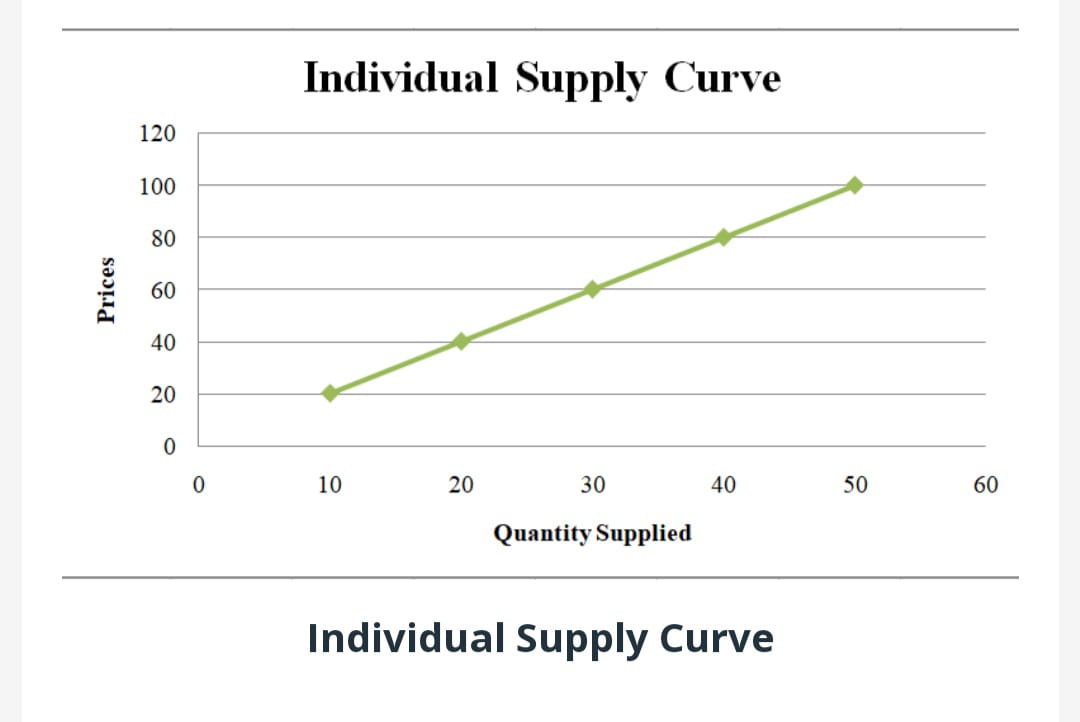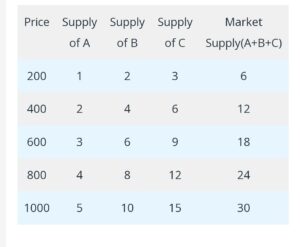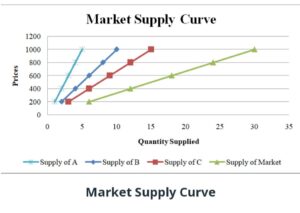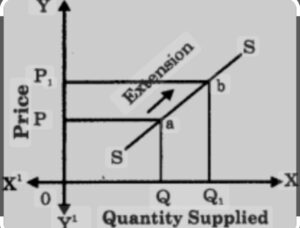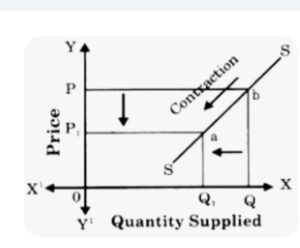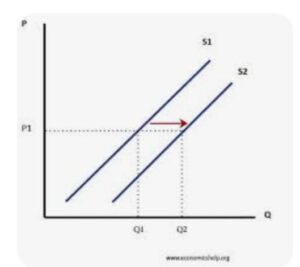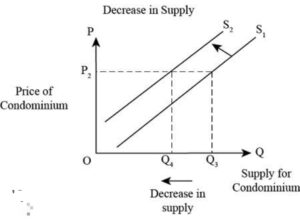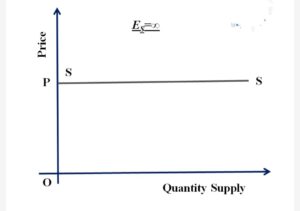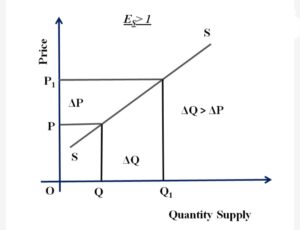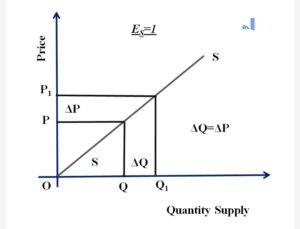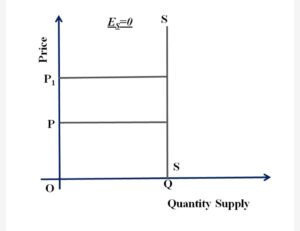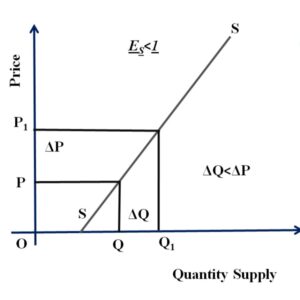Micro Economics part 2
Micro Economics part 2 is the basic economics that covers Production Function , supply and it’s elasticity that covers the Syllabus of class 11
Production function:
The relationship between physical input and physical output of a firm is generally referred to as production function.
The general form of production function is,
q = f ( x1 ,x2)
where, q = output, x1 = 1 input like labour, x2 = another input like machinery.
Variable factors are those factors, which can be changed in the short run. They vary directly with the output. For example, Labour, raw material, etc.
Fixed factors are factors which cannot be changed in the short run. They do not vary directly with the output. For example, Capital, land, plant and machinery, etc.
A short period is the period of time in which a firm cannot change some of its factors like plant, machinery, building, etc. due to short of time but can change any variable factor like labour, raw material, etc therefore in short run, there will be some factors of production that are fixed at predetermined levels, e.g., a farmer may have fixed amount of land.
A long period is a time period due to change in demand. Here all the factors of production are variable we can change according to requirement of output.
This distinction depends merely upon how quickly factor inputs can be change by producers in an industry.
Short run production function can be defined, when application of one factor is varied while all the other factors are kept fixed (constant). The law that operates here, is known as “law of returns to a factor”.
For example, on 5 acres of land, 1 labour can be employed. So, initially factor ratio will be 5 : 1, when we employ another labour, the factor ratio changes to 5 : 2. So, factor ratio changes during short period.
Long run production function can be defined as, when application of all the factors is varied (changed) in the same factor proportion, the law that operates in such a situation is known as law of returns to scale’.
In this a firm can change all its factors of production including land, labour, machines, building, organization, etc.
In other words, it is a period of time during which supplies can adjust.
Total Product, Average Product And Marginal Product
Total product :
It refers to total volume of goods and services produced by a firm with the given input during a specified period of time.
In a short period of time if a firm wants to increase its total product then it can do so by increasing the variable factors of production only because fixed factors of production remain fixed and cannot be changed with the fluctuation in production.
However, in the long period, increase in all the factors of production can increase level of output. In short run, total product can be increased up to a particular point only because after that point TP starts decreasing.
Total Product, we have to add Marginal Product It is the sum of Marginal product .
Total Product, we can use this formula:
Total product=APL x Units of variable factor AP is average product . It is also called total return to the input
Average product : It is per unit total product of variable factors. It is calculated when total product is divided by number of units of variable factors It is also known as average return to the inputs employed
Average Product=Total Product/Unit of Variable Factor
8. Marginal Product:
It is an addition to the total product when an additional unit of a variable factor is employed.
MP=Change in output /Change in input =Δq/ΔL
4. Total Product, Average Product and Marginal Product with the help of schedule and diagram are as follows:
Scheduled
Fixed factor(Land) : — 1—- 1—–1——1—–1—–1—–1
variable factor(labour) 0—1—–2——3—–4—–5—-6
Total product (TP) 0—10—30—-45—-52—52–48
Marginal product (MP) —–10—20—15—–7—-0– -4
In the above schedule land is made fixed factor as one unit , labour is made variable factor which changes from 0 -6 units as the number of labour increases from 0 to 2 unit TP &MP increases with increases rate than after from 3 and 4unit of labour TP increases with diminishing rate but MP falls at 5th unit of labour MP is Zero but TP is maximum after that TP falls and MP is negative.
Explanation of a Curves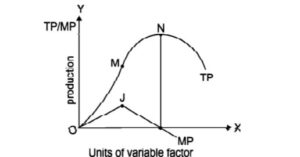
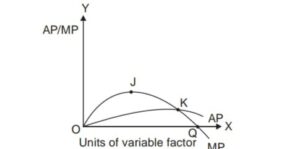
TP increases continuously from points O to M. It increases at an increasing rate (convex shape) from O to N and at a diminishing rate (concave shape) from M to N. TP is maximum at N and remains so upto point N. After point N Total product falls.
MP curve initially rises, reaches its maximum and ultimately declines taking the shape of inverted U Similarly, AP curve first rises, reaches its maximum and then declines taking the shape of an inverted U.
Return to a variable factor states that change in the physical output of a good when only the quantity of one input is increased, while that of other input is kept constant.
Law Of Variable Proportions
The law of variable proportion states that as we increase the quantity of only one input, keeping other inputs fixed, the total product increases at an increasing rate (convex shape) in the beginning, then increases at diminishing rate (concave shape) and after a level of output ultimately falls.
Assumptions of Law of Variable Proportions
(a) Only one input is variable, the other is held constant or fixed.
(b) It is possible to change the proportion in which the factor units are combined.
(c) It assumes a short run.
(d) The state of technology is given and remains unchanged.
(e) Price of factors of production do not change.
It can be explained with the help of schedule and diagram:
Scheduled
Fixed factor(Land) : — 1—- 1—–1——1—–1—–1—–1
variable factor(labour) 0—1—–2——3—–4—–5—-6
Total product (TP) 0—10—30—-45—-52—52–48
Marginal product (MP) —–10—20—15—–7—-0– -4
In the above schedule land is made fixed factor as one unit ,variable factor changes/ increases TP first increases with increasing rate and MP also increases , after that from 3 rd and 4th unit TP increases with diminishing Rate Mp falls but at 5th unit TP is maximum than after falls and at this point MP is zero and finally become negative.
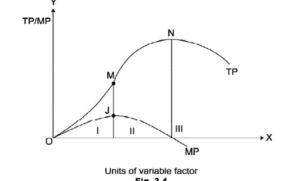
4. Explanation of Each Phase
Phase I: Phase of increasing return or Increasing Return to factor
It is called the stage of increasing returns. The total product increases at an increasing rate (convex shape) up to point M. The marginal physical product of labour (MP) is increasing and reaches its highest point MJ vertically downwards to point M.(c) Point M is called the point of inflexion. At point M, the curvature of the TPP curve changes. It stops increasing at an increasing rate and starts to increase at a diminishing rate.
In the first stage, firm is moving towards achievement of ideal combination of factors in which TP is increasing at an increasing rate at every level of output. So, instead of stopping its production, the firm will continue employing additional units of a variable factor.
Phase II:
Stage of Diminishing Returns or Diminishing Return to factor
The total product (TP) continues to increase, but at a diminishing rate (concave shape) and eventually becomes the highest. MP is diminishing but is positive.
The stage comes to an end,
when Marginal Product (MP) = Zero and Total Product (TP) is maximum and constant.
The firm would like to operate in the second phase because TP is maximum and there is proper utilization of fixed factor.
Phase III: Phase of Negative returns or Negative Return to factor
In this stage the total product declines in absolute terms. The marginal product becomes negative.
The firm cannot operate in the third stage where MP is negative and TP starts declining as we are moving beyond the optimum degree of specialisation.
There are causes for the operation of increasing returns
Proper utilisation of the fixed factor .In the initial stage of production the units of variable input i.e., labour) is so less that fixed inputs cannot be effectively utilized.
Proper utilization of the fixed factor can be attained when more and more units of variable factor (labour units) are applied to the fixed factor (land), the fixed factor will be used intensively and output will increase rapidly.
Indivisibility of fixed factor means that due to technological requirements a minimum amount of fixed factor must be employed, whatever the level of output, i.e., fixed factor cannot be divided into smaller units therefore as more units of variable factors are employed with an indivisible fixed factor, output increases due to fuller and more effective utilization of the fixed factor.
Specialisation and division of labour In the beginning there was only one labour working on all the 5 acres of land ploughing, watering, etc.As the number of labour increases, each worker specialised in a particular activity leads to specialisation of the variable units and this resulted in increased output.
Reasons for diminishing returns:
The non-optima! combination of variable factor with the fixed factor When a given quantity of a fixed factor is combined with more and more units of variable factor, the additional units of variable factor will have smaller and smaller quantity of fixed factor to work with them.
As many workers share the same fixed factor, the share of each would obviously fall. Therefore, the cooperation of the fixed factor is not available to the same extent. Thus, an increase in the variable factor would add less and less to total output.
(b) Imperfect Substitutes:
Diminishing return to factor occurs because variable factor and fixed factor are imperfect substitutes to each other. There is a limit to which variable factor can be applied to fixed factor and that limit depends upon the efficiency of fixed factor.
So, variable factor and fixed factor are imperfect substitutes to each other.
Reasons for Negative returns:
Scarcity of Fixed Factor
During a short period, there is a limitation that we cannot change the fixed factor. So, variable factor can be change upto a certain limit and that limit depends upon the efficiency of fixed factor. If we cross that limit, the total product starts falling.
(b) Efficiency of Variable Factor Fall
In this stage the amount of variable factor becomes excessive relative to the fixed factor. This happens when too many LABOUR are engaged in cultivating on a given piece of land. They cause overcrowding and chaos and thus hamper each other’s work.
In such a case, the contribution of additional labour to production is bound to be negative. Thus, the marginal returns become negative and the total returns start diminishing.
(c) Efficiency of Fixed Factor Fall
Too much of a variable factors may also lead to the inefficiency of the fixed factor as well. In case of machine, which is a fixed factor, too much of labour may cause lot of wear and tear of machinery, frequent breakdowns and excessive cost of maintenance.
This is bound to affect total production adversely. In such a situation it is advisable to reduce the units of the variable factor than to increase it with a view for getting maximum production.
Law Of Diminishing Marginal Returns
1. The Law of diminishing marginal return states that when we applied more and more units of variable factor to a given quantity of fixed factor, total product increases at a diminishing rate and marginal product falls.
2. Law of diminishing marginal returns is a classical theory and classical economists treated it as a separate Law. But according to modern economists, this law indicates just one aspect (aspect of diminishing returns) of law of variable proportion.
schedule
fix factor (land ) | 1 — 1—– 1—- 1 —- 1 —–
labour /variable | 1 2 3 4 5
TP | 12 22 30 36 40
MP | 12 10 8 6 4
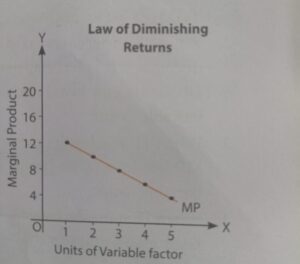
In the above schedule and diagram when more units of variable factor are employed with a given quantity of fixed factor TP increases at a diminishing rate or MP goes on falling. That is why shape of MP curve is a downward sloping

Relation between TP and MP
i) As long as TP increases with increasing rate MP rises
ii)When TP increases with diminishing rate MP falls
iii) When TP is maximum MP is zero
iv) When TP falls MP is negative
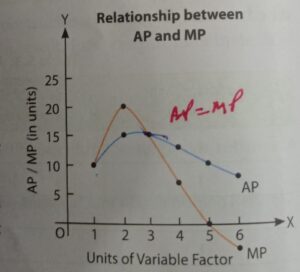
Relation between AP and MP
i) When MP rises AP also rise but with less rate
ii) When AP is maximum AP= MP
iii)When MP is less than AP ,it falls with higher rate than MP
